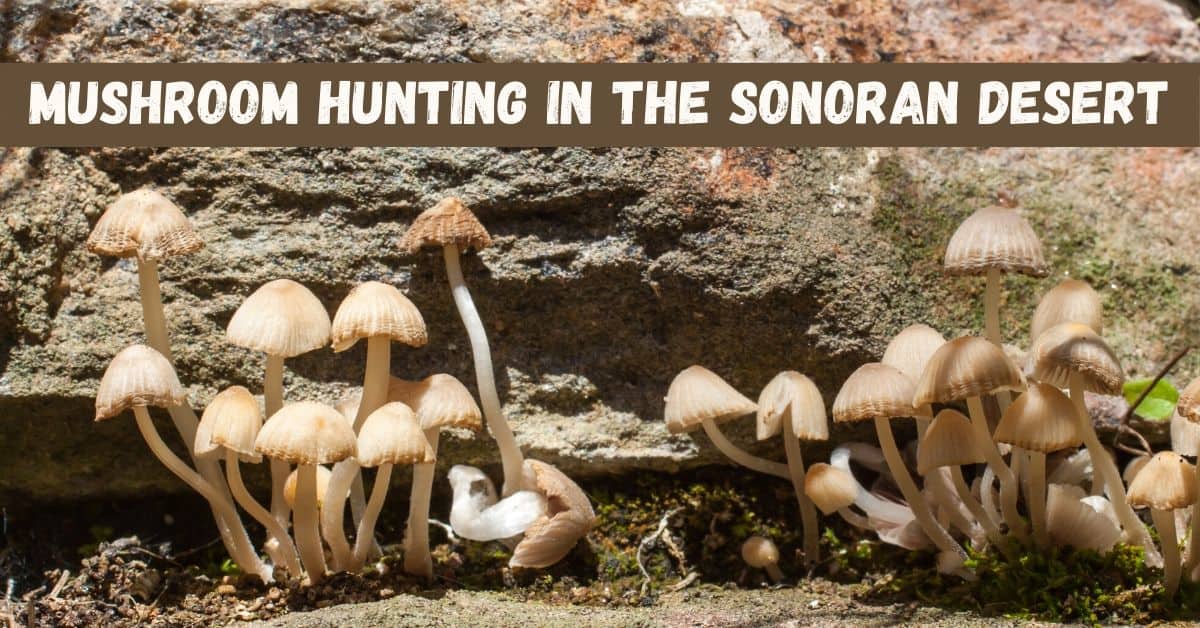- Finding the Right Indoor Plants for Desert Your Home - April 28, 2023
- Common Misunderstanding About Sun Exposure - April 18, 2023
- All about the Arizona Monsoon Season - May 21, 2021
When you think of mushroom hunting you probably picture a mossy forest floor and damp fallen logs. What probably doesn’t come to mind is the arid land of the Sonoran Desert – but, surprisingly, the intrepid mycophile can find a wide range of mushrooms in the myriad microclimates of the region.
Learn With an Expert
First, a few words of wisdom for mushroom hunting in Arizona and beyond. Misidentified mushrooms can be deadly poisonous so it is important to learn mushroom gathering and identification from knowledgeable sources. Joining a local mushroom club, like the Arizona Mushroom Society, is one of the best ways to get started with mushroom foraging. Group mushroom hunting can teach you important regional specifics about finding and identifying as well as delicious methods for preparing the edibles you find.
Never, ever consume mushrooms you have not 100% identified. Mushrooms like the very toxic destroying angel can be mistaken for edible varieties without proper expertise. That said, foraging mushrooms for fun (and dinner!) can be a compelling pastime. Finding them in unexpected pockets of the Sonoran Desert can make the hunt all the more rewarding.
A Diversity of Climates
As we mentioned at the start, most people associate wild mushrooms with shady, wet woodlands – for a good reason! Wet forests are a prime spot for finding a wide variety of mushroom species, especially those that feed off of dead wood. But fungi are also surprisingly tenacious, and species of fungi have adapted to nearly every climate on earth.
One example of this in the Sonoran Desert is the proliferation of lichens found in even the harshest arid areas. Lichens are formed from fungi and algae living in symbiosis. Lichens are considered a composite organism where both the fungi and the algae benefit each other as they grow together. Lichens can develop in striking almost fluorescent greens and oranges (as well as more subtle shades of grey and rust) and they can be found on a wide variety of stones and boulders.
Some mushrooms even make the hottest and driest parts of the Sonoran Desert their home. Desert shaggy mane mushrooms and giant stalked puffballs thrive in harsh desert conditions and can be found sprouting in desert parks and even urban empty lots.
Many other species may be present in the Phoenix area for the urban mushroom hunter. While the arid heat is not conducive to many species, watered lawns and gardens can support mushroom growth with enough moisture. Many common mushrooms can be found in garden soils or other irrigated landscapes like golf courses. At high desert elevations, some strange and distinct mushroom species may be spotted, such as earthstar fungi. Earthstars are similar to puffball mushrooms, with a large central spore sac bursting out of tough cortex “petals” that split into a star shape collar. Many of the arid mushrooms found in central Arizona dry quickly and are inedible or of unknown edibility.
Head For the Hills
Central Arizonans know that there’s more to the Sonoran Desert landscape than just heat – and that’s a key component to finding some of the better mushroom hunting spots in our area. Heading to forested mountains and upland pine forests will get you to some of the choicest locations for finding edible species. Many of central Arizona’s high peaks exist as a bioregion called a “sky island” where the moisture temperature and general climate is distinctly separate from the surrounding lowland.
The Madrean sky islands of Arizona are home to many forest flora and fauna that could not exist in the desert heat of lower altitudes. Up here, it is also possible to find species of choice edible mushrooms like boletes, hedgehog mushrooms, wild oyster mushrooms and even coveted morels.
Getting Started
It’s important to observe foraging laws and etiquette wherever you search for mushrooms. Be sure you are foraging in areas where it is legal to harvest flora and don’t harvest from protected habitats. Take only the mushrooms you can use and leave small undeveloped mushrooms alone so they can fully develop. While mushroom hunters can be secretive about their favorite spots, joining a mycological society or mushroom club can help you connect with areas of active mushroom growth. With the summer monsoon season on its way, now is a great time to start looking for Sonoran Desert mushrooms!
CC Sunscreens
After a day of foraging for mushrooms, why not kick back on your patio to look through your finds? We’re proud to say that patio sunscreens from CC Sunscreens can make all the difference! Custom patio screens make your outdoor hangs comfortable by keeping out heat and harmful UV rays. Call us at CC Sunscreens today to learn more about our patio screens.

